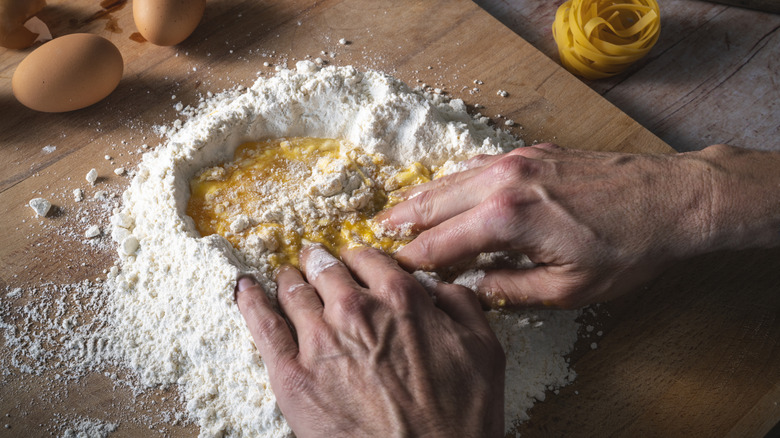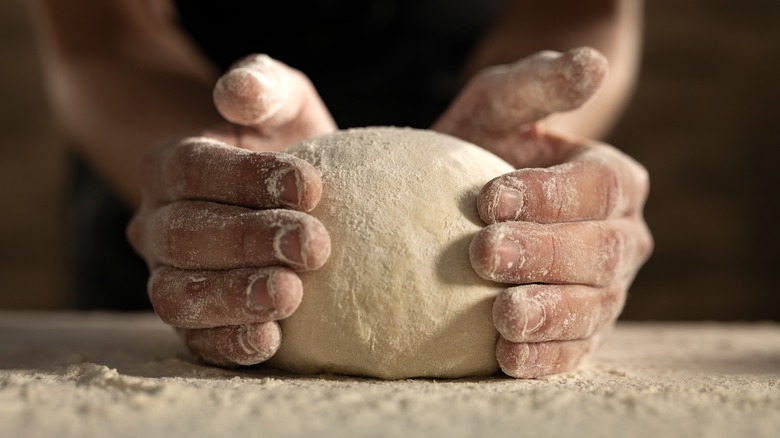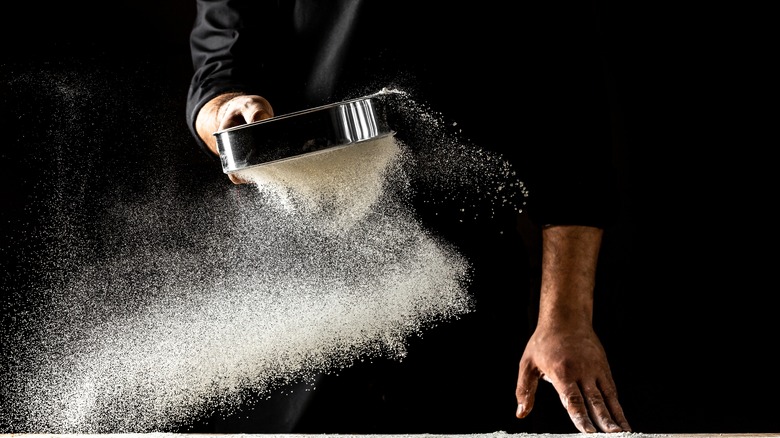The Volcano Method For Perfect Pasta Dough
It can be a little intimidating to make pasta by hand versus using a machine. From the outside looking in, it can seem like a very labor-intensive process perfected only by Italian nonnas. But with the proper know-how and a little practice, anyone can whip up the perfect pasta dough at home. For the best results (with hardly any effort), you should use the volcano method.
With this traditional approach to pasta making, you take your finely milled flour (and clean hands), build a mound resembling a volcano, and make a sizeable indentation or well in the center for mixing your eggs. The technique is referred to as fontana (fountain) in Italian, likely because its shape is similar in appearance to the fountains found in many piazzas around the European nation.
With the volcano formed and your eggs in place, you can scramble them with a fork or your fingertips before slowly incorporating bits of flour from the sides. It's important not to let any of the liquid spill out as you mix, so you'll want to take flour from all around the edges of your crater rather than just one side, which will help keep the well's integrity intact. Before long, the dough will start to come together; just keep kneading it until it forms a smooth, elastic ball. As easy as it may be, it's worth understanding how this process produces flawless pasta.
Why the volcano method works so well for making pasta
To some, the volcano method of pasta-making might seem like a bit much. You may be thinking, "I just want to cook some spaghetti. Why can't I mix the flour and eggs in a bowl and avoid making a mess on the counter?" But there's solid logic behind this ingenious technique. As Roberto Aita, chef and owner of Aita, a trattoria in Brooklyn, New York, explains, it allows for better control over the dough's moisture level, ensuring you end up with dough that has a consistent texture. "By touching it, you can see and feel the amount of liquid that goes in, and stop adding water at exactly the right moment," he told Epicurious.
Indeed, the volcano method works so well because it allows the pasta maker the flexibility to incorporate the flour gradually. This is helpful because egg size is not standardized, and you may find you have more liquid from some eggs than others. On the other hand, if your dough is looking a bit dry as it forms, you can add some water to help it coalesce.
The other essential component you need for perfect pasta dough
Before you go and painstakingly sculpt Mount Vesuvius, you'll want to make sure you're starting out with the right flour for pasta making. For impressive homemade pasta, the unrivaled best flour to use is Italian 00. The numerals are actually a type of grading system that describes the grain size. "00" refers to the most refined and finely ground flour that is powdery in consistency, while a grade of "2" signifies flour that has bigger particles. 00 is especially great for pasta because its protein content is a bit higher than other varieties, around 12 or 13%, which helps to create a more malleable dough. The soft powder also helps craft pasta that is silky smooth.
Other types of flour that can work well for pasta-making include semola and semolina. They are essentially the same thing and made from hard wheat, but the semola flour is twice milled, while the semolina flour is a bit more coarse. Some chefs and home cooks opt for semolina because the end product is less chewy and tends to hold its shape better than other varieties of flour. Others like to mix 00 and semolina for sturdiness. Specialty flour can be a little tough to track down, but it is carried in most specialty grocery stores or you can order it online.


